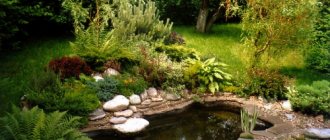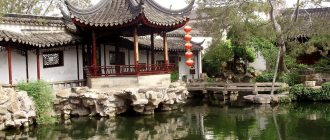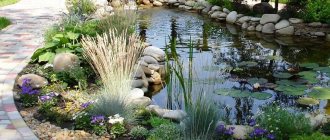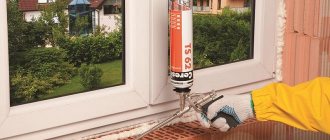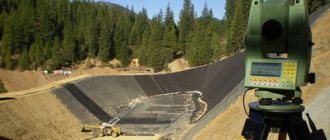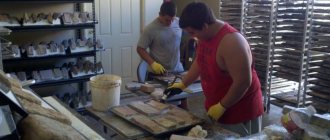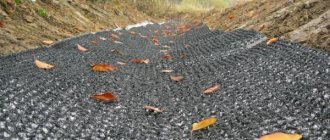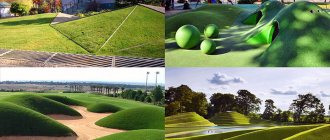Where does the creation of a pond begin?
The creation of a pond begins with its design, taking into account the size, shape and landscape of the land. The project begins with choosing the location of the pond and its shape. The larger the area of the plot, the larger the pond can be. Although even a small and shallow pond can become a true decoration of the site.
When designing, the following circumstances must be taken into account:
- choice of pond shape (square, round or winding);
- the water in the pond should not be exposed to direct sunlight for more than 6 hours a day, otherwise algae and bacteria will begin to actively multiply in the water;
- the possibility of taking water from the pond and replenishing it using the runoff of melt or storm water or from a nearby spring.
Stage 5. Lay the film
Film laying
Step 1. Cover the bottom of the pit with a 15-centimeter sand “cushion” and compact it thoroughly.
Step 2. To protect the PVC film from damage, lay a layer of roofing felt (laying is done with an overlap).
Step 3. Cover the bowl of the reservoir with film. We do this freely, with a small margin along the banks. We press the ends of the film with bricks.
Butyl Rubber Pond Film
Step 4. Fill the pond with water, but do not rush to cut off the excess film. It is necessary to wait approximately 24 hours for the polyvinyl chloride coating to take on its final volume. Then we cut the film, place its edges in a previously made trench, tuck it in and fill it with crushed stone.
Adding individuality Laying stones on the edge Filling the pond with water Filling the pond with water
Pond design styles
The design style of the pond should match the style of the country house and the entire site. There are two main styles:
- formal;
- free.
The formal style of the pond is characterized by regular, sometimes slightly smoothed geometric shapes (square, oval, circle, ellipse, polygon). To the greatest extent, this style is used when equipping a pond on a small suburban area. As a rule, a pond of regular geometric shape is separated from other elements of the landscape.
The purity of the water in the pond is ensured by plants in the regeneration zone, separated from the main pool by a dividing barrier. To decorate such a pond, mosaic or stone is usually used. It can be decorated with fountains, small waterfalls, bridges or various lighting.
Formal ponds include shallow reservoirs raised above the ground Plants near such a mini-pond are planted in boxes or tubs.
Such ponds look great in small paved gardens, visually increasing their space. They also go well with a patio or patio, especially if there are flower beds or sidewalk paths nearby.
Free style requires space and an appropriate style of garden layout. It must be deep enough (minimum depth is 50 cm) and have an area of at least 5 m2.
The irregular contours of the banks of the pond give it a feeling of naturalness. coastal plants (cattail, fern, iris, Volzhanka) necessarily
The stream flowing into it looks natural, for the arrangement of which a slight difference in height between the beginning of the stream and the shore of the pond is enough.
If you want to create a pond by constructing a dam on a natural stream, then it is better to initially conduct pre-design studies so as not to later cause a local environmental disaster (swamping or drainage of the territory).
It is not recommended to build ponds in areas with marshy soil or where there are water problems.
Additional events
To do this, you will need to purchase seeds of perennial grasses or small trees and simply sow as densely as possible on the top of the bank and, if possible, on steep slopes.
The second stage will be decorating the shore. If the shore is sandy, then you can simply bury the visible parts of the coconut mat, and if it is grassy, then you can add more stones or earth - this will create additional strength and ensure the beauty of the entire shore.
There are many advantages of using coconut mat, here are the main ones:
- The material is environmentally friendly, because it consists exclusively of natural elements.
- Cheapness is one of the main parameters if you need to cover large areas.
- The installation work is very simple, even one person can handle it within a few hours.
- For several years the slope will not erode or slide.
- The mesh structure allows plant roots to pass through it, which will provide additional strength.
- The strength of the material is not lost from sunlight, contact with water and from the decomposition of natural organic matter.
As you can see, your problem with landslides from constant contact with water can be solved very quickly with the help of your hands, because no additional knowledge is required. In addition, there will be no need to spend a lot of money or obtain permits from government authorities.
https://youtube.com/watch?v=dm0GWyw5OuA
By spending only a couple of hours of your time, you will forget about the problem for 2-3 years, or maybe more, because if there is a lot of vegetation on the shore, it will create tangles of roots and its own mesh, which will continue to hold the shore after the decomposition of the coconut mat. Also, after a couple of weeks, no one will be able to guess that the bank is reinforced, because the material will no longer be noticeable.
Choosing the location, size and material of the pond
When choosing a location for a pond, it is important to keep in mind that a pond in a suburban area serves a decorative role and is not intended for swimming or fish farming. The correct choice of location for the pond is the key to its long-term functioning without spring and summer flowering.
Recent Entries
Chainsaw or electric saw - what to choose for the garden? 4 mistakes when growing tomatoes in pots that almost all housewives make Secrets of growing seedlings from the Japanese, who are very sensitive to the soil
An important role when choosing a place for a pond is played by the illumination of the future water surface. It is advisable that the sun hits the water at the beginning of the first or late afternoon. At midday, the water surface should be covered with the shadow of plants planted along the banks. The pond should be illuminated by the sun no more than 6 hours a day and be open from the southwest.
The optimal size of the pond should not exceed 3% of the area of the garden plot. When determining the size of a pond, it is necessary to take into account the harmony of its perception, that is, its size must be combined with other elements of the landscape.
It is advisable to divide the pond into three zones according to its depth:
- coastal;
- shallow;
- deep (for wintering fish).
The pond should not be made too deep - 150 - 180 cm (below the depth of soil freezing). The area of the deep-water part should be approximately 20% of the total area of the pond.
The following materials can be used to create a pond:
- concrete pit (used for ponds of regular geometric shape);
- use of ready-made plastic containers (their disadvantage lies in their strictly defined shape and small volume);
- the use of a special moisture-resistant film for laying out the bowl of the pond (used when creating a pond according to an individual project).
Capital bank protection
Capital bank protection can reduce to a minimum the likelihood of damage to the coastline from the destructive effects of water. This group of bank protection works includes technologies based on the use of gabions, geomats, sheet piles, hydraulic grades of concrete, and special volumetric reinforced concrete structures.
Gabions are meshes made of galvanized double-twisted wire, which at the installation site are laid out in boxes filled manually with large natural stones. To securely fasten individual structures to the ground, special anchors are used. The boxes are twisted together with wire. After the gabion is partially filled with stone backfill, so-called “braces” are installed, which prevent the opposite walls of the box from “diverging” to the sides.
The banks of reservoirs, reinforced with gabion structures, do not erode or float. For many years, the contour of the coastline specified during bank protection works is preserved. This technology, long used in Europe, has found application in Russia. You can see gabion structures on ponds, rivers, bypass canals and other bodies of water.
The river bankline is neatly decorated with gabion structures that have a strict geometric shape. Natural stone, located in mesh boxes, harmonizes perfectly with the autumn forest
Sheet piles made from PVC and composite materials allow you to strengthen the coastline in the shortest possible time. This method of bank protection is considered low-budget. PVC sheet piling is most suitable for arranging steep banks. One of the advantages of this material is the possibility of its reuse. During installation, individual sheet piles are lined up into a continuous, dense wall. Reliable connection of adjacent elements is ensured by a longitudinal rib protrusion located on each sheet pile. Driving of single or paired PVC sheet piles is carried out using autonomous hydraulic equipment, selected taking into account ground conditions.
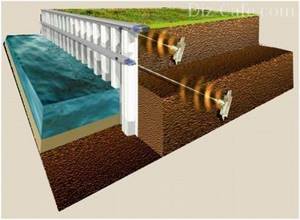
Schematic representation of the installation of sheet piles made of PVC materials, allowing to strengthen the steep bank of an artificial or natural reservoir
Pond creation technology
Creating a pond based on a finished container is carried out easily and quickly within 2 days and includes the following steps:
- In the place chosen for the pond, a container is placed on bricks. Its contours on the ground are marked with light sand or lime.
- Along the outlined contours, expanding the marking by 10 cm, a pit is carefully dug, the base of which is carefully compacted.
- The container is installed in the pit. Using a level, you need to make sure that the container is installed strictly horizontally.
- The bowl of the container is filled one third with water, and the space between the walls of the pit and the container is filled with sand, which is periodically watered.
Free-form ponds are created using a waterproofing film made of polyethylene, PVC or butyl rubber. Butyl rubber film is considered the best. Its thickness depends on the depth of the pond: if the depth does not exceed 80 cm, then the thickness of the film used is 0.8 mm, otherwise - 1.5 mm.
The stages of arranging a pond using film technology are as follows:
- Light sand or lime marks the contours of the shores of the pond and the contours for different depths.
- A pit is dug, starting from a shallower zone.
- The bottom of the pit is filled with sand, on which geotextiles or fiseline are laid, which serve as protection for the film from stones and roots.
- A film is laid on top, the edges of which should extend 50 cm beyond the edges of the pit. The film is pressed with stones to the bottom and terraces of the pit.
- Gradually the pond fills with water. In this case, the film should settle slowly.
- After a few days, the coastal zone is formed. The edges of the film are tucked in and stones or slabs are laid on them, the gaps between which are filled with pebbles or sand.
How to strengthen the banks of a pond at your dacha with your own hands
An artificial reservoir pleasantly diversifies the landscape, but if mistakes were made during construction, the banks will begin to crumble after a while. The soil “slides”, the pond silts up, the film that lines the pond or an unsightly concrete base is visible along the edges. It is better to immediately strengthen the banks of the pond at the dacha in order to decorate them without fear of erosion. When choosing a method, you need to take into account the size of the reservoir, features of use and your financial capabilities.
The most popular methods for doing the work yourself
The most well-known technical methods for protecting a reservoir from collapse are gabions and geogrids. Both methods are based on the use of a mesh structure, which protects the walls and banks of the reservoir from crumbling.
Features of geogrid installation
To strengthen the pond with your own hands in this simple way, you will need:
- geogrid with suitable cell size;
- geotextiles for drainage;
- anchors for fastening and pneumatic stapler;
- shovel;
- filler.
The top layer of soil is removed, drainage is laid, and a geogrid is placed on it. The individual sections are fastened together. The cells are filled with crushed stone, frost-resistant concrete, soil or other material. If plants are planted in the soil filling the cells, their roots will additionally strengthen the bank.
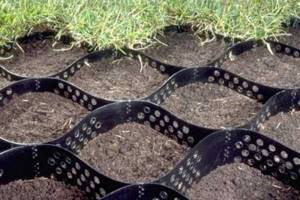
The choice of filler for mesh cells is a matter of taste
Gabion structures for decoration and strengthening
Gabions are one of the most reliable methods for strengthening banks and walls. Boxes made of wire, fastened to each other, are installed along the edge of the reservoir. The corners are fixed. Using gabions, you can build retaining structures along the shore.
Densely filled with crushed stone larger than the openings of the cells, gabions serve not only to strengthen, but also to decorate the reservoir. The porous structure eliminates the need for additional drainage. Over time, this structure becomes even stronger due to filling with soil and the growth of plants.

Gabion structures for bank decoration
Biomats and plants – caring for the environment
How to strengthen a pond at the dacha so as not to disturb the existing landscape and give the pond a natural charm? The most environmentally friendly method is to strengthen the shore of the pond using the root system of plants planted along the coastal zone. However, it is quite difficult to independently select specimens that will prevent shedding. It will take time for the plantings to grow, but there is a risk that they will not take root. Suitable for the middle band:
- weeping willow;
- sea buckthorn;
- Red Ribes;
- sedge;
- marsh iris;
- cattail and other species;

Plants help make a pond a natural part of the landscape
With the help of coconut mats, the strengthening of a pond in a dacha is carried out even with very steep slopes (up to 60%). The slope is leveled, and natural fiber mats are laid on it with an overlap of 20 cm. They are attached to the pond film with waterproof mounting adhesive. Then a thin layer of soil is poured and the lawn is sown.
Large stones and boulders look very attractive, which can be used to lay out a fence near the water after installing a geogrid or biomat.
Decorating a steep bank with piles
Piles are the oldest method of strengthening reservoirs. Traditionally, piles were made of wood, but strengthening the shore of a pond with your own hands using wood is not as simple as it seems at first glance. Hardwood piles look impressive, but driving them requires special equipment. Another “minus” is that over time the wood may darken. Special impregnations help, but are not a panacea.
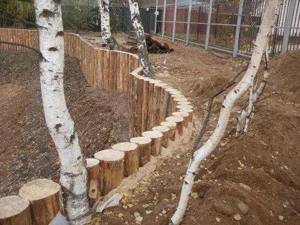
Wooden piles to strengthen the bank
PVC piles are a modern alternative to wood; they will last for decades, but their installation also requires special equipment. For a small reservoir, using the pile method is not very convenient.
The pond will retain its original appearance for a long time if you think about strengthening it at the pit stage. To do this, the work must be supervised by a professional who will assess the steepness of the slope, the size of the reservoir, the characteristics of the soil and advise which type of reinforcement to choose.
After consulting with specialists, you will learn how to strengthen a pond at your dacha with your own hands or, having assessed your strengths, you will be able to order all the work on a turnkey basis.
Plants and fish for the pond
biological balance in it, the pond needs plants that are divided into:
- underwater plants (play a major role in saturating the water with oxygen);
- plants whose roots are under water and whose stems are above water;
- plants whose roots are in watery soil and whose stems are above water;
- plants floating on water (suitable for small ponds).
The most common aquatic plant is water lilies (water lily), which block the sun and prevent the water from blooming. Among the coastal plants of dacha ponds, underwater buttercups, kotula, and marsh marigold are often found. Pontederia with large shiny leaves is very popular. It blooms from July to September with spike-shaped pale blue flowers and is not afraid of frost.
Calamus is used to decorate the banks of the pond. To maintain biological balance in a pond, hornwort, which has no roots, is often used.
Fish are an indispensable attribute of a country pond, bringing a certain balance and enlivening it. They eat various larvae, mosquitoes and other small insects.
A pond looks more colorful if it is populated with colorful decorative fish swimming near the surface.
It is recommended to buy fish for a pond in late spring - early summer, when the water in the pond has warmed up enough. It is better to buy adult specimens that can more easily adapt to new conditions. They can be introduced into the pond a month after the pond is filled with water and populated with plants. This period is necessary to establish bio-equilibrium in the pond.
goldfish, shubunki, and then all the others (black telescope, Japanese koi carp, golden orpha, golden rudd, etc.) populate the pond The number of fish in a pond depends on its size: per 0.1 m2 of pond area there should be 2.5 cm of fish body length.
Feed the fish once a day with dry food. In winter, they can be left without feeding for some time. It is necessary to ensure that in winter the pond does not freeze to the bottom.
Strengthening river banks with plants
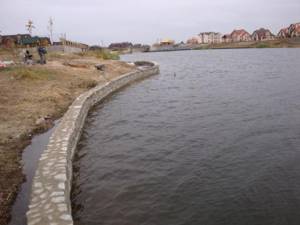
The riverbank can also be strengthened using plants for this. They must have a fairly strong branched root system that will be resistant to flooding. This method is acceptable only in cases where the river flow speed is no more than 1 m per second, while the waves do not exceed 0.3 m. The river bank can be strengthened with plants, herbaceous flora and shrubs, among them:
- amorphous;
- marsh iris;
- manna;
- sea buckthorn;
Aquatic vegetation is planted in the underwater zone; in this case, aquatic iris can be used. As soon as the planting has been carried out, the sod should be carried out.
